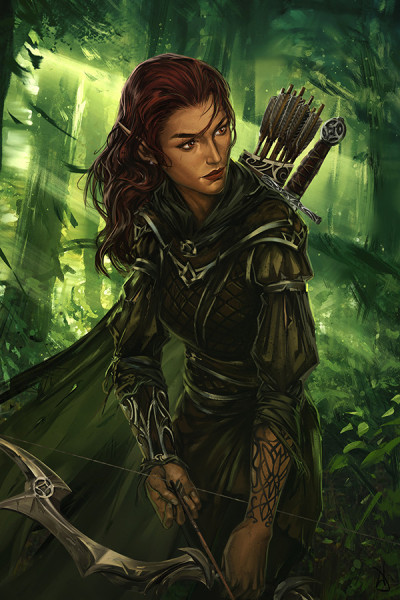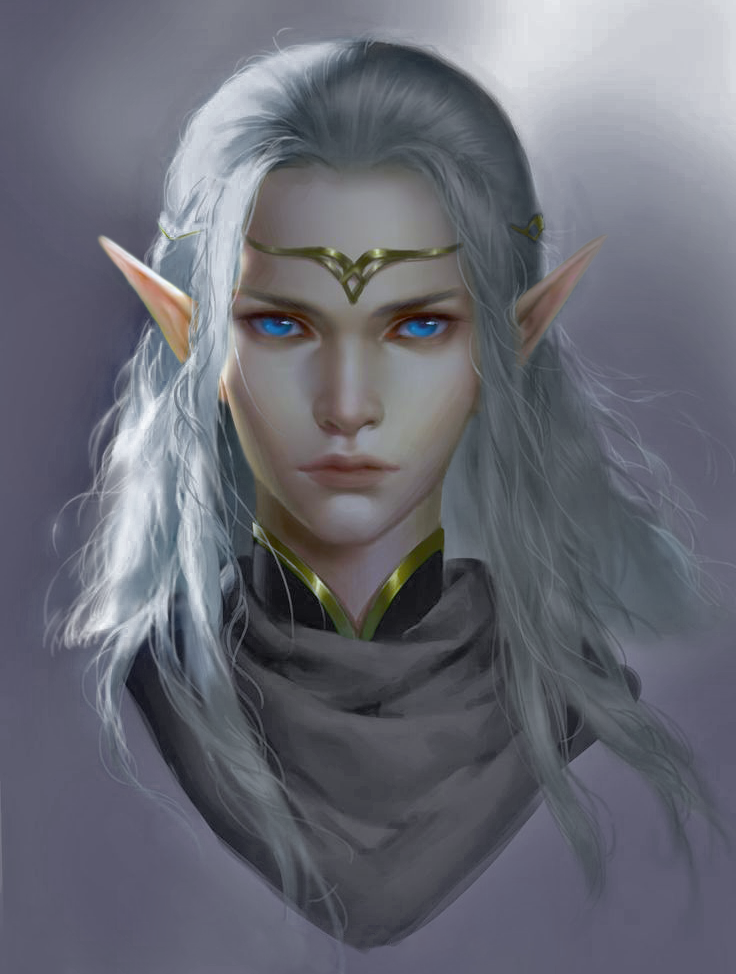Elves
"We were the children of the Dreamland, descendants of the Shee, and then we were taken. By the Jötunn. The giants. To tend their houses, grow their crops...to fight their wars. They separated us from our home, from the lands gifted to us by the Gods themselves, and cursed us. Cursed us for our inability to fight against them with the mortality that cripples this plane." "Hm? No, my son, I am fine. There is no need to look at me with worry in your eyes. I have long since accepted the idea that I may never see the green hues of our once home. I have settled and stated myself with the tales told by my father, just as I am now telling you. It is, most likely, what you will have to do, in times. Ah, but do not look at me with such sad eyes. Do not lose hope. There are those of us who still search for a way to return, as you and I are doing right now. Perhaps one day, we will find such a means." "And if we do not? Well, that is the question then, isn't it, my son? Ah, well, then we will make do. We will try to keep to the old ways. We will survive. Though... Try not to become what the Empire has settled for, at least unwittingly, my boy. Do not accept the mortality and ways of Man that have been thrust upon us all. Or at least, if you do settle, do so willingly and without regret, as your mother has done. "
Naming Traditions
Feminine names
High Elven: Alda, Bertha, Elizabeth, Edith,
Wood Elven: Birel, Enna, Lia, Melona, Naivara, Thia
Masculine names
High Elven: Bren, Dieter, Conrad, Haines, Karl
Wood Elven: Adran, Aust, Berrian, Carric, Riardon
Unisex names
Wood Elven: Bryn, Lael, Rinn, Naeris, Thiar
Family names
All elves have a given name, generally accompanied by a derived name they called in childhood, as well as a surname. However, the naming traditions, especially of surnames, change dramatically between the two ethnicities of elves. High Elves have modernized their naming traditions, taking derivations from their newer Elven Imperial Tongue. Wood elves, on the other hand, have kept to the naming traditions of old, deriving their children's given names from Sylvan. Wood elves also often tend to lack formal surnames, instead taking the name of the Clan that they were born of, or are traveling with, as a last name. Both High Elves and Wood elves view the other's naming conventions with minor disdain.
Culture
Major language groups and dialects
High Elves generally speak in the Imperial Elven Tongue. Some traders and merchants also converse in the Imperial Common tongue, which is linguistically similar to its cousin, Cadorian. Wood elves, on the other hand, are often fluent in both Imperial Elven, and Slyvan. While they are occasionally taught the Imperial Common Tongue, their relatively insular nature and constant traveling makes its teaching rare.
Culture and cultural heritage
The Elves were created when the Div tribe, the Shee, refused to partake in the war against the Gods. The Shee were originally cursed by the god Kador, like the other Div, but were then granted another, more merciful, choice by the rest of the divine host. They could either be stripped of the heavenly fire in their blood, or could be stripped of the gift of will. The heavenly fire belied the Shee's power. Their immortality. The gift of will allowed for them to stand both with and against the gods, on equal footing with those who ruled them. Thus, the Shee were divided. Those that chose to keep their fire, bent their will to that of the Gods, and were ordered away. Those that remained lost their powers, but remained unbent and unbroken. Those that remained would eventually become the Arch Fey.
The Shee that left were granted the Feywilds, also known as the Dreamlands, as a home. Legends say that the Old Gods gave a part of themselves to create the new plane, and to them, the Shee were grateful. The Shee slowly adapted to the new land, becoming the Eladrin, the Fey of the World. They attuned to the very nature of the Wilds, itself, tethering themselves to the nature that surrounded them. There, they resided in peace until the giants came. The giants took the Eladrin from their homes, brought them to the plane of Orbem, and enslaved them. The Eladrin fought for and against their new masters until the fall of the giants, where the survivors attempted to find a way to return to the Feywilds. The way, however, was shut to them. The fire, their power, their immortality that they had bowed to the gods to protect, was gone.
The Eladrin could no longer dream, could no longer feel the thrum of the earth's magic beneath their feet, nor hear the song of the winds. Thus, they became the elves.
The elves slowly split along more ideological lines, with those wanting to settle and acclimatize to the new land becoming the High Elves, and those wishing to continue to travel and hunt for a means to go back becoming the Wood Elves. The High Elves slowly began to build cities and establish trade networks, while the Wood Elves took to the forests and rivers, becoming increasingly desperate to remain attached to their old ways.
In the past millennia, the High Elves established an imperial power called the Zau'ber Empire, and, much to their Wood Elven brethren's horror and disgust, began participating in the slave trade. This trade only compounded with the discovery of the New World in recent years, though it remains sequestered to the races not of the Tree.
Shared customary codes and values
While the two subgroups differ greatly in their approach toward dealing with the future, they do both hold their past experiences in high regard. They respect the attempts they made to survive. Both groups know that they were the children of the Feywilds, and many of both groups wish to return to their ancient homeland. The majority of the High elves, however, have simply accepted that this return is likely impossible, and that the best way to continue surviving is to modernize. The Wood Elves, on the other hand, refuse to relinquish the remains of their old customs. Because of these polarizing views, the two groups typically view the other with slight pity and disagreement.
Common Dress code
Both elven subgroups tend to wear their hair long, and typically are seen wearing lighter armors when in combat. Generally, high elves tend to garb themselves in softer silks, cottons, and clothes from foreign lands. Wood elves, on the other hand, tend to be found in leathers, wools, and furs that they have gathered from their relatively self-reliant communities and groupings.
Both types of elves are fond of gold, silver, and previous stones, and often garb themselves in jewelry that they have either made or traded for.
Common Taboos
Wood Elves forbid the marrying of their kind with the shorter lived non-elves. They also disdain the slave trade that their Imperial counterparts have initiated. The Wood Elves generally hold the belief that the High Elves have forgotten the centuries of slavery that they, themselves were forced to endure. High Elves are far less morally stringent than their Wood Elf relatives, for better or worse.
Ideals
Beauty Ideals
Both types of elves enjoy the concept of beauty, often praying to the Goddess Aymara for guidance in that regard. Both enjoy wearing longer hairstyles that are typically crafted each morning, and enjoy wearing carefully selected garment that are meant to highlight their desirable features. Elven features are often seen as superior to human or dwarven visages, though such beliefs are not ubiquitous. High Elves tend to view fairer hair as more favorable to darker, though again, this view is not held by all. In almost all elven standards, however, there is a undercurrent of tension.
Up until relatively recently, blood purity was desired (if not mandated), especially among the nobility. While such standards are slowly starting to lax, the sight of more human or mortal features is often viewed with distaste. This is especially true of beards, which some of the newer, even fully elven generations are starting to grow. This younger generation, however, has started to sport their goatees, in the typical youthful rebellion.
Courtship Ideals
Elven courtship tends to be slow yet constantly growing, often likened to a plant or other life-form. Typical courting can take decades to reach a fruition, with many outsiders considering the process dragging and overly restrained. When initiating courtship, it is often custom to provide the object of one's affections a token of intent, which is often an item of great wealth or personal import.
Partnerships are often focused on compatibility and potential stability, rather than overwhelming passion, desire, or sentimentality. Some elves do fall for the latter, however, though they are seen as reckless by their elders, generally.
Relationship Ideals
Relationships and marriages are typically viewed with much seriousness among both types of elves. Even among the later generations, long life spans mean that such partnerships are oftentimes centuries-long endeavors, and many youths are warned from falling into love too quickly, or too passionately. Marriage is seen as a partnership, where both parties are on equal footing, rather than a situation where one party is more subservient to the other. As such, the vast majority of elven marriages are made to last until both parties have passed. It is typical for a widow or widower to never marry again after their spouse has passed, though such marriages are occasionally seen.
Issues can arise, however, with marriages between elves and non-elves. The reservations that many elves are taught can be viewed as coldness by their non-elven interests, lending to miscommunication. The elven communities also view such unions as either flings or on-coming tragedies, as half-elven offspring tend to be notoriously short lived when compared to their elven parent. Wood elves take the firmest stance against such couples, tending to forbid any such marriages among their people. Even so, the number of half-elven children continue to grow in the boundaries of the empire.
Major organizations
The High Elves rule the Zau'ber Empire.The Wood Elves nominally serve under the Empire's will, albeit with a large amount of freedoms that the other races are not allowed. The High Elves also rule the majority of the Arcane Congress, the main governing body of the Empire and hold most positions of power in the racially diverse empire.
Wood Elves also tend to gather in groups called enclaves. Notable Wood Elf enclaves include:
- The Relkathi: The Wardens of the Wood. Wood elves that live in Imperial territory and have a civil, if strained relationship with their Imperial brethren. A massive Treant serves as their spiritual leader and protector. A sapling of Eliwyn is likewise growing there and under heavy guard.
- The Verena: Live on an island to the south and have developed largely in isolation following their escape from the giants, forming their own society. The Immortal Court rules over them. Think of it as an amalgamation of their ancestors. Spirits of ancient elves that refused to pass on and maintain some connection to the feywild.
Wood Elven Scout
High Elven Mage
Lifespan
650 years; varied
Average Height
5-6'. Wood Elves tend to be shorter than their High Elven counterparts.
Average Weight
130lbs. Wood Elves tend to be slighter than their High Elven Counterparts
Diverged ethnicities
Related Organizations
Remove these ads. Join the Worldbuilders Guild











